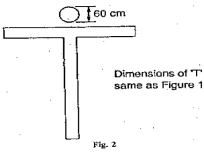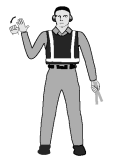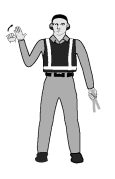- Latest available (Revised)
- Original (As made)
The Rules of the Air Regulations 2007
You are here:
More Resources
Status:
This is the original version (as it was originally made). This item of legislation is currently only available in its original format.
SECTION 9AERODROME SIGNALS AND MARKINGS—VISUAL AND AURAL SIGNALS
General
56.—(1) Within the United Kingdom any signal or marking which is specified in this Section and which is given or displayed—
(a)by any person in an aircraft; or
(b)at an aerodrome; or
(c)at any other place which is being used by aircraft for landing or take-off,
shall have the meaning assigned to it in this Section.
(2) Apart from those referred to in rule 60(6) and the distances at which markings must be placed, all dimensions of signals or markings specified in this Section of these Rules shall be subject to a tolerance of 10 per cent, plus or minus.
Signals in the Signals Area
57.—(1) Whenever any signal specified in this rule is displayed it shall be placed in a signals area, which shall be a square visible from all directions bordered by a white strip 30 centimetres wide and with the internal sides measuring 12 metres.
(2) A white landing T, as illustrated in this paragraph,
signifies that aeroplanes and gliders taking off or landing shall do so in a direction parallel with the shaft of the T and towards the cross arm, unless otherwise authorised by the appropriate air traffic control unit.
(3) A white disc 60 centimetres in diameter displayed alongside the cross arm of the T and in line with the shaft of the T, as illustrated in this paragraph,
signifies that the direction of landing and take off do not necessarily coincide.
(4) A white dumb-bell, as illustrated in this paragraph,
signifies that movements of aeroplanes and gliders on the ground shall be confined to paved, metalled or similar hard surfaces.
A white dumb-bell, as described in paragraph (4), but with a black strip 60 centimetres wide across each disc at right angles to the shaft of the dumb-bell, as illustrated in this paragraph,
signifies that aeroplanes and gliders taking off or landing shall do so on a runway but that movement on the ground is not confined to paved, metalled or similar hard surfaces.
(5) A red and yellow striped arrow, as illustrated in this paragraph,
the shaft of which is one metre wide and which is placed along the whole or a total of 11 metres of two adjacent sides of the signals area, and pointing in a clockwise direction, signifies that a right-hand circuit is in force.
(6) A red panel 3 metres square with a yellow strip along one diagonal 50 centimetres wide, as illustrated in this paragraph,
signifies that the state of the manoeuvring area is poor and pilots must exercise special care when landing.
(7) A red panel 3 metres square with a yellow strip 50 centimetres wide along each diagonal, as illustrated in this paragraph,
signifies that the aerodrome is unsafe for the movement of aircraft and that landing on the aerodrome is prohibited.
(8) A white letter H, as illustrated in this paragraph,
signifies that helicopters shall take off and land only within the area designated by the marking specified in rule 59(7) .
(9) A red letter L displayed on the dumb-bell specified in paragraphs (4) and (5), as illustrated in this paragraph,
signifies that light aircraft are permitted to take off and land either on a runway or on the area designated by the marking specified in rule 59(8).
(10) A white double cross, as illustrated in this paragraph,
signifies that glider flying is in progress.
Markings for paved runways and taxiways
58.—(1) Two or more white crosses, as illustrated in this paragraph,
displayed on a runway or taxiway, with each arm of each cross at an angle of 45° to the centre line of the runway, at intervals of not more than 300 metres signify that the section of the runway or taxiway marked by them is unfit for the movement of aircraft.
(2) Subject to paragraph (3), two yellow broken lines and two continuous lines, as illustrated
in this paragraph, signify the designated visual holding position associated with a runway beyond which no part of a flying machine or vehicle shall project in the direction of the runway without permission from the air traffic control unit at the aerodrome during the notified hours of watch of that unit.
(3) Outside the notified hours of watch of that unit or where there is no air traffic control unit at the aerodrome the markings referred to in paragraph (2) signify the position closest to the runway beyond which no part of a flying machine or vehicle shall project in the direction of the runway when the flying machine or vehicle is required by virtue of rule 42(3) to give way to aircraft which are taking off from or landing on that runway.
Subject to paragraph (5), a yellow marking, as illustrated in this paragraph,
signifies a holding position other than that closest to the runway beyond which no part of a flying machine or vehicle shall project in the direction of the runway without permission from the air traffic control unit at the aerodrome during the notified hours of watch of that unit.
(4) Outside the notified hours of watch of that unit or where there is no air traffic control unit at the aerodrome the marking referred to in paragraph (4) may be disregarded.
(5) Orange and white markers, as illustrated in this paragraph,
spaced no more than 15 metres apart, signify the boundary of that part of a paved runway, taxiway or apron which is unfit for the movement of aircraft.
Markings on unpaved manoeuvring areas
59.—(1) Markers with orange and white stripes of an equal width of 50 centimetres, with an orange stripe at each end, alternating with flags 60 centimetres square showing equal orange and white triangular areas, spaced not more than 90 metres apart as illustrated in this paragraph,
indicate the boundary of an area unfit for the movement of aircraft.
(2) One or more white crosses, as specified in rule 58(1), also indicate such an area as is referred to in paragraph (1).
(3) Striped markers, as specified in paragraph (1), spaced not more than 45 metres apart, indicate the boundary of an aerodrome.
(4) On structures markers with orange and white vertical stripes, of an equal width of 50 centimetres, with an orange stripe at each end, spaced not more than 45 metres apart, as illustrated in this paragraph.
indicate the boundary of an aerodrome.
(5) The pattern of the marker referred to in paragraph (4) shall be visible from inside and outside the aerodrome and the marker shall be affixed not more than 15 centimetres from the top of the structure.
(6) White, flat, rectangular markers 3 metres long and 1 metre wide, at intervals not exceeding 90 metres, flush with the surface of an unpaved runway or stopway, indicate the boundary of the unpaved runway or stopway.
(7) A white letter H, as illustrated in this paragraph,

(8) A white letter L, as illustrated in this paragraph,
indicates a part of the manoeuvring area which shall be used only for the taking off and landing of light aircraft.
(9) A yellow cross with two arms each 6 metres long by 1 metre wide at right angles, indicates that tow ropes, banners and similar articles towed by aircraft shall only be picked up and dropped in the area in which the cross is placed.
(10) A white double cross, as illustrated in this paragraph,
indicates an area which shall be used only for the taking off and landing of gliders.
(11) Subject to paragraph (12) a white landing T, as specified in rule 57(2), placed at the left-hand side of the runway (when viewed from the direction of landing) indicates the runway to be used for take-off and landing.
(12) The white landing T referred to in paragraph (11), when placed at an aerodrome with no runway, indicates the direction for take-off and landing.
Signals visible from the ground
60.—(1) A black ball, 60 centimetres in diameter, suspended from a mast signifies that the directions of take off and landing are not necessarily the same.
(2) A chequered flag or board, 1.2 metres by 90 centimetres, containing 12 equal squares, 4 horizontally and 3 vertically, coloured red and yellow alternately, signifies that aircraft may move on the manoeuvring area and apron only in accordance with the permission of the air traffic control unit at the aerodrome.
(3) Two red balls, 60 centimetres in diameter, positioned vertically one above the other, 60 centimetres apart and suspended from a mast, signify that glider flying is in progress at the aerodrome.
(4) Black, Arabic numerals in two-figure groups and, where parallel runways are provided, the letter or letters L (left), LC (left centre), C (centre), RC (right centre) and R (right), placed against a yellow background, indicate the direction for take-off or the runway in use.
(5) A black letter C against a yellow background, as illustrated in this paragraph,
indicates the position at which a pilot can report to the air traffic control unit or to the person in charge of the aerodrome.
(6) A rectangular green flag of not less than 60 centimetres square and not more than 66 centimetres square, flown from a mast, indicates that a right-hand circuit is in force.
Lights and pyrotechnic signals for control of aerodrome traffic
61. Each signal described in column 1 of Table 4 shall have the meanings respectively appearing in columns 2, 3 and 4 of the Table in the circumstances specified in the second row of the Table.
Table 4—Meaning Of Lights And Pyrotechnic Signals
| Column 1 | Column 2 | Column 3 | Column 4 |
|---|---|---|---|
| Characteristic and colour of light beam or pyrotechnic | Directed from an aerodrome to an aircraft in flight | Directed from an aerodrome To an aircraft or vehicle on the aerodrome | Directed from an aircraft in flight to an aerodrome |
(a) Continuous red light. | Give way to other aircraft and continue circling. | Stop. | — |
| (b) Red pyrotechnic light, or red flare. | Do not land; wait for permission. | — | Immediate assistance is required. |
| (c) Red flashes. | Do not land; aerodrome not available for landing. | Move clear of landing area. | — |
| (d) Green flashes. | Return to aerodrome; wait for permission to land. | To an aircraft: you may move on the manoeuvring area and apron. To a vehicle: you may move on the manoeuvring area. | — |
| (e) Continuous green light. | You may land. | You may take off (not applicable to a vehicle). | — |
| (f) Continuous green light, or green flashes, or green pyrotechnic light. | — | — | By night: May I land? By day: May I land from direction different from that indicated by landing T? |
| (g) White flashes. | Land at the aerodrome after receiving continuous green light, and then, after receiving green flashes, proceed to the apron. | Return to starting point on the aerodrome. | I am compelled to land. |
(h) White pyrotechnic lights. Switching on and off the navigation lights. Switching on and off the landing lights. | — | — | I am compelled to land. |
Marshalling signals (from a marshaller to an aircraft)
62.—(1) Each of the signals for the guidance of aircraft manoeuvring on or off the ground, described in column 1 of Table 5 and as illustrated in column 3, when given by a marshaller to an aircraft, shall have the meanings specified in column 2 of the Table.
(2) By day any such signals shall be given by hand or by circular bats and by night shall be given by torches or by illuminated wands.
Table 5—Meaning of Marshalling Signals (from a marshaller to an aircraft)
Marshalling signals (from a pilot of an aircraft to a marshaller)
63. Each of the signals described in column 1 of Table 6, when made by a pilot in an aircraft to a marshaller on the ground, shall have the meanings specified in column 2 of the Table:
Table 6—Meaning of Marshalling Signals (from a pilot of an aircraft to a marshaller)
| Column 1 | Column 2 |
|---|---|
| Description of Signal | Meaning of Signal |
| 1. Raise arm and hand with fingers extended horizontally in front of face, then clench fist. | Brakes engaged. |
| 2. Raise arm with fist clenched horizontally in front of face, then extend fingers. | Brakes released. |
| 3. Arms extended palms facing outwards, move hands inwards to cross in front of face. | Insert chocks. |
| 4. Hands crossed in front of face, palms facing outwards, move arms outwards. | Remove chocks. |
| 5. Raise the number of fingers on one hand indicating the number of the engine to be started. For this purpose the aircraft engines shall be numbered in relation to the marshaller facing the aircraft, from his right to his left. For example, No. 1 engine shall be the port outer engine, No. 2 engine shall be the port inner engine, No. 3 engine shall be the starboard inner engine and No. 4 engine shall be the starboard outer engine. | Ready to start engines. |
Distress, urgency and safety signals
64.—(1) The following signals, given either together or separately before the sending of a message, signify that an aircraft is threatened by grave and imminent danger and requests immediate assistance—
(a)by radiotelephony—
the spoken word ‘MAYDAY’;
(b)by visual signalling—
(i)the signal SOS (… --- …);
(ii)a succession of pyrotechnic lights fired at short intervals each showing a single red light;
(iii)a parachute flare showing a red light;
(c)by sound signalling other than radiotelephony—
(i)the signal SOS (… --- …);
(ii)a continuous sounding with any sound apparatus.
(2) The following signals, given either together or separately, before the sending of a message, signify that the commander of the aircraft wishes to give notice of difficulties which compel it to land but that he does not require immediate assistance—
(a)a succession of white pyrotechnic lights;
(b)the repeated switching on and off of the aircraft landing lights;
(c)the repeated switching on and off of its navigation lights, in such a manner as to be clearly distinguishable from the flashing navigation lights described in rule 49.
(3) The following signals, given either together or separately, indicate that the commander of the aircraft has an urgent message to transmit concerning the safety of a ship, aircraft, vehicle or other property or of a person on board or within sight of the aircraft from which the signal is given:
(a)by radiotelephony—
the repeated spoken word, ‘PAN PAN’;
(b)by visual signalling—
the signal XXX (- .. -- .. -- .. -);
(c)by sound signalling other than radiotelephony—
the signal XXX (- .. -- .. -- .. -).
Options/Help
Print Options
PrintThe Whole Instrument
PrintThe Whole Schedule
PrintThis Cross Heading only
Legislation is available in different versions:
Latest Available (revised):The latest available updated version of the legislation incorporating changes made by subsequent legislation and applied by our editorial team. Changes we have not yet applied to the text, can be found in the ‘Changes to Legislation’ area.
Original (As Enacted or Made): The original version of the legislation as it stood when it was enacted or made. No changes have been applied to the text.
More Resources
Access essential accompanying documents and information for this legislation item from this tab. Dependent on the legislation item being viewed this may include:
- the original print PDF of the as enacted version that was used for the print copy
- lists of changes made by and/or affecting this legislation item
- confers power and blanket amendment details
- all formats of all associated documents
- correction slips
- links to related legislation and further information resources
More Resources
Use this menu to access essential accompanying documents and information for this legislation item. Dependent on the legislation item being viewed this may include:
- the original print PDF of the as made version that was used for the print copy
- correction slips
Click 'View More' or select 'More Resources' tab for additional information including:
- lists of changes made by and/or affecting this legislation item
- confers power and blanket amendment details
- all formats of all associated documents
- links to related legislation and further information resources






















































